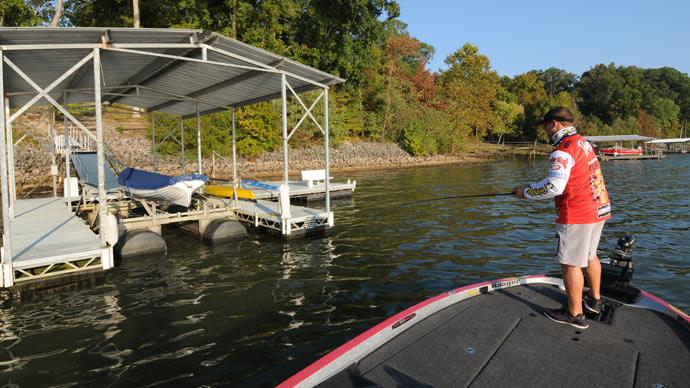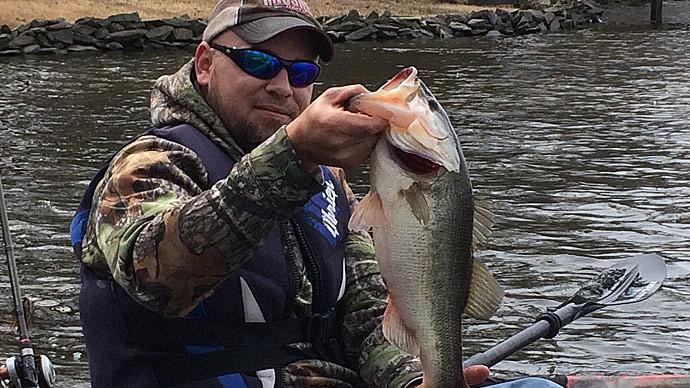
Selecting the right hook when fishing soft plastic baits is a relatively simple choice that can dramatically impact your lure's action and hooking percentage. What kind of hooks do you use for bass? Based on the size of the fish, the hook set style used, and how heavy or lightweight your rods and line are, there is a hook that will maximize your landing percentage for each bait. For Texas rigs, weightless Texas rigs, and Carolina rigs, there are a few basic guidelines that I follow. While you may find a different system works better for you, hopefully, this will help you more critically evaluate your hook choice in the future.
For traditional rigging of soft plastics, hooks come in three main styles, i.e., straight shank, offset shank, and extra-wide gap (EWG.) Straight shank hooks have a "J" shape. Offset shank hooks have a similar design but have a slight double ninety-degree bend (offset) near the eye of the hook to help keep lures from sliding down the shank. Extra-wide gap hooks are more in a "G" shape, with a rounded shank similar to Kahle style hooks and an offset near the eye.
Straight shank hooks were the dominant worm hook for years, until the introduction of the Slug-Go in the 80s, creating widespread use of offset hooks. As flipping tubes became popular in the 90s, extra-wide gap hooks became widespread. I now see more bass fishermen using extra-wide gap hooks with soft plastic lures than other hook types.
Like a growing number of anglers, I used a lot of extra-wide gap hooks in the past. I have now switched back to using straight shank hooks whenever possible. Currently, I use straight shank hooks about 80% of the time, offset hooks 15%, and wide gap hooks only about 5%. My reasoning is based on simple geometry. Wide gap hooks have the hook point directly in line with the eye of the hook, or slightly above the line eye on "wide gap plus" hooks. When you set the hook, the sinker and the front of the lure clear a path for the hook point to escape a bass' mouth without embedding.
On the other hand, on straight shank hooks, the point rides substantially above the eye of the hook and aims for the roof of the bass' mouth, resulting in more hook-ups. The extra-wide gap hooks do an excellent job of holding fish if you manage to set the hook into the bass' mouth on the hook set, so well that I often need pliers to remove a hook once the bass is landed.
However, when a bass takes a bait, and even on a short pitch with braided line to a bedding fish, the hook flies cleanly out of the bass' mouth on the hook set. Missing an extra fish every once in a while doesn't sound like a big deal, but if that fish is the one you need to get a check in a tournament or the lunker of a lifetime, losing it is a huge deal.

Based on my preference for straight shank hooks, here's a breakdown of my hooks. For rigging worms, creature baits, craw worms, French Frys, or similar baits like Ring Frys, Fork Worms, Twitch Worms, Fork Craws, and Fork Worms by Lake Fork Tackle, I use straight shank hooks. An offset worm hook works better for weightless soft plastic jerk baits like Magic Shads, Zig Zags, or Senkos. These baits have thick bodies that deliver the best action and hook-ups when rigged Texposed with offset hooks. Offset hooks have the hook above the eye, similar to straight shank hooks, and produce much higher hook-up percentages for me than extra-wide gap hooks while still delivering good action.
I'll use extra-wide gap hooks for extremely bulky baits, baits that you swim, and tubes. For Fork Frogs and Live Magic Shads, the extra-wide gap hooks act as a keel to keep the lures running true while having enough gap to get through the thick bodies. And for Texas rigging hollow-bodied tubes like Lake Fork Tackle Craw Tubes, extra-wide gap hooks are the only ones that will rig them properly.
The biggest drawback to straight shank hooks is the head of the bait sliding down the shank instead of staying on the eye of the hook. This is even a problem with offset and extra-wide gap hooks when fishing soft plastics around heavy brush or grass. While there are several novel ideas and new hook designs to combat this problem, the simplest solution is to use the end of a toothpick. Break off the end of a round toothpick and push it through the head of your lure, continuing through the eye of the hook and out the other side of the head of the lure. Trim the toothpick, so it is flush with both sides of your bait, and it'll be locked in place at the eye on any style of hook.
Once you've determined the hook style, you need to determine the best size. Selecting the size of the hook is another subject upon which my thinking has changed over the years. I would have used the largest hook possible in the past, figuring that larger hooks were more robust and would land more fish. Nowadays, I prefer using the smallest hook I can get away with. While it is true that larger hooks often have a heavier wire that is stronger than light wire hooks, when two hooks of similar-sized wire are compared, the larger hook will straighten out easier. Just like a long wrench will loosen a tight bolt easier than a shorter wrench, the larger the hook and especially the wider the gap, the more leverage for big fish to bend out your hook.
For that reason, I've switched to mostly 2/0 and 3/0 hooks for most of my Texas rigs and Carolina rigs instead of the 4/0 and 5/0 hooks I predominately used in the past. Furthermore, smaller hooks typically have smaller points, making them easier to penetrate the bass' mouth, especially on long casts. The rule of thumb for selecting hooks size is based on the bulk of a soft plastic lure, not the length. For example, I use a 3/0 or 4/0 hook when Texas is rigging a bulky 4" Ring Fry, while I'll only use a 1/0 or 2/0 hook for rigging a skinny 6" Twitch Worm. The bulkier the lure, the bigger the hook gap needs, so you'll need to use a larger-sized hook. Concerning the wire thickness of the hook, in general, I'll use light wire hooks when I'm using a line that is about 10 lbs or less and go to the extra strong "Flipping" or "Superline" hooks when I'm using a line that is 20 lb test or larger and fishing in a lake with big fish.
Keep your hooks sharp and give my tips a try. I think they'll help you land a few extra fish or two this season. Here's hoping you catch the lunker of your dreams.




